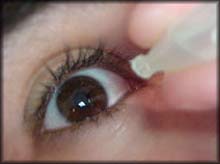Anemia due to eye drops
Due to effective treatment of conjunctivitis, it is sold without a prescription, so chloramphenicol eye drops are easily abused. This can lead to aplastic anemia - the disease has killed some people.
The 0.4% ophthalmic chloramphenicol solution was put into use in 1948 and is still commonly used in many countries. This is a bacteriostatic antibiotic with broad spectrum activity, acting on many gram-positive and gram-negative bacteria. The drug works on most agents that cause acute conjunctivitis in adults and children.
 (Photo: sweye.com) So far, there have been very few reports of drug resistance, although the drug has been used for decades. Comments on the association between the use of ophthalmic chloramphenicol and aplastic anemia have appeared in the US since 1965. After a death due to aplastic anemia related to chloramphenicol eye drops was published in In 1982, in the United States, the use of chloramphenicol eye drops was reduced by 90%.
(Photo: sweye.com) So far, there have been very few reports of drug resistance, although the drug has been used for decades. Comments on the association between the use of ophthalmic chloramphenicol and aplastic anemia have appeared in the US since 1965. After a death due to aplastic anemia related to chloramphenicol eye drops was published in In 1982, in the United States, the use of chloramphenicol eye drops was reduced by 90%.
In 1995, in the UK, a medical journal mentioned the problem of chloramphenicol eye drops related to aplastic anemia and called for limited doctors to prescribe chloramphenicol ophthalmic.
In theory, chloramphenicol ophthalmic can be absorbed through the vascular system in the conjunctiva. Part of the drug goes into the nasal duct system - virtually (so users can feel the bitterness of the drug after eye drops) and then into the digestive tract to absorb.
The medical literature in the country and the world have been recorded, by using whole body, chloramphenicol causes significant side effects: Blue-gray syndrome (vomiting, fast breathing, abdominal distension, blue violet, green manure, lethargy progress to vascular collapse and death; Visual neuritis, peripheral neuritis, delirium.
On the digestive system, chloramphenicol causes glossitis, unpleasant taste, stomatitis, nausea. The drug also causes allergy to erythema manifestations, urticaria, angioedema and anaphylactic shock. For children under 1 month old, the use of systemic chloramphenicol can cause acute circulatory syndrome. Do not use this medicine for children under 2 years old.
Chloramphenicol also causes myelosuppression, understanding mildly is reducing reticulocytes, increasing iron in the plasma, stopping maturation of precursors of red blood cells. This condition can recover after 1-3 weeks of stopping the drug.
Aplastic anemia is the most dangerous complication due to the use of chloramphenicol ophthalmic. This accident does not depend on chloramphenicol dose, occurs even after stopping the drug weekly, even monthly. Although chloramphenicol eye drops have little absorption into the blood, patients with a history of self or family bone marrow failure should not be used.
There have been use cases of aplastic anemia that does not recover for a lifetime. Therefore, the use of eye drops must follow the doctor's instructions.
Dr. Tran Nhan Thang
- Young anemia and identification signs
- What should anemia eat to stay healthy?
- New hope for patients with Mediterranean anemia
- Using stem cells to treat genetic anemia
- Eye drops can prevent myopia in children
- Gene therapy can help patients with anemia
- Low vitamin D increases the risk of anemia in children
- Anemia
- Benefits when eating bananas
- Signs of anemia
- Breakthrough: Treating myopia and farsightedness with eye drops
- Anemia can cause dementia
 Green tea cleans teeth better than mouthwash?
Green tea cleans teeth better than mouthwash? Death kiss: This is why you should not let anyone kiss your baby's lips
Death kiss: This is why you should not let anyone kiss your baby's lips What is salmonellosis?
What is salmonellosis? Caution should be exercised when using aloe vera through eating and drinking
Caution should be exercised when using aloe vera through eating and drinking